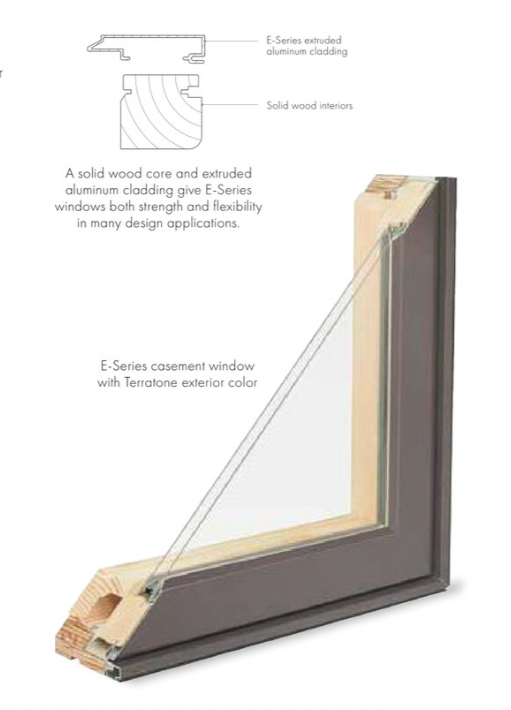
Aluminum Clad vs Fiberglass Windows
As a homeowner, you may find it challenging to select a new replacement window. There are many brand and customization options. You need to consider energy efficiency, style, safety, aesthetics, and durability before choosing your preferred window.
Aluminum clad and fiberglass windows are two options you'll encounter while researching window types by material. In this post, we'll explore the differences between these two window materials to help you narrow down to a preferred option. Read on for more insights.
Use the links below to skip ahead
- Aluminum Clad vs Fiberglass Windows
- Window Construction
- Window Aesthetics
- Window Durability
- Window Energy Efficiency
- Window Cost
- Window Availability
Aluminum Clad vs Fiberglass Windows
When comparing these two window materials, you should focus on the following key elements: construction, aesthetics, durability, maintenance, energy efficiency, cost, and availability. You should also consider the pros and cons of each type, as highlighted below.
Pros and Cons of Aluminum Clad Windows
- Condensation resistant
- Strong and durable
- Increased building thermal performance
- Doesn't swell or warp
- Requires low maintenance
- Water can get behind low quality cladding
- Impervious to insect attack, corrosion, and decay
- Can withstand extreme temperatures
- Energy efficient
- It comes in different sizes, styles, and shapes
- Fewer color options
- Difficult to find
Initially, the roll form in the old-fashioned aluminum windows had a slight thickness comparable to a soda can which was subject to chalking, fading, and dents. This has since changed with manufacturers like Marvin using extruded aluminum cladding with greater thickness. Generally, aluminum-clad windows are made of wood with a protective layer on the outside, usually wrapped around the frame and the sash. The cladding requires little maintenance and is highly durable. You can paint or stain the beautiful wood on the interior to match your home's décor.
Fiberglass windows are made through a pultrusion procedure. This process involves weaving fiberglass strands together, then pulling them through a resin bath and a heated die to cure the resin. The result is usually grid linear and smooth that is then fitted together, coated, and cut into different lengths.
Window Aesthetics
Aluminum windows have a wide range of aesthetic looks. You can go for the sleek and modern appearance or the historically accurate replacement windows with basic frames. Aluminum window frames are often slimmer, offering lots of glass area. On the other hand, fiberglass windows are a bit thinner, so they are easily cut and molded into different shapes and styles to suit your curb appeal. Moreover, they are highly adaptable, allowing you to use them just like normal windows.
Window Durability
Aluminum is the strongest window frame, making it highly durable than fiberglass. The frame can withstand extremely hot temperatures, making it perfect for warm locations and commercial buildings where windows are under greater stress. However, if you use aluminum windows in wet areas such as close to the ocean, the saturated salt in the air can easily corrode them.
Fiberglass windows are also strong but not as strong as aluminum. They still, however, are strong and durable enough for your residential property, though you'll have to periodically paint these windows due to paint chipping and color fading.
Notably, both materials are stable and can hardly experience warping. Also, they can easily last up to 20-30 years, with aluminum getting slightly more than this lifespan.
Window Energy Efficiency
Aluminum windows, especially older styles, have always had a bad reputation for energy efficiency. Metal is a heat conductor, so it doesn't manage heat loss in homes. However, the modern aluminum styles come with thermal breakers, insulating materials incorporated into the frame. Thermal breaks↗ help reduce thermal heat flow and keep the interior of your home warm.
Fiberglass windows offer way better numbers when it comes to energy efficiency. The glass pane and wood core play a significant part in insulating your home. Also, fiberglass windows have minimal contraction and expansion rates, eliminating possible air leaks because the seal remains tight.
Window Cost
Although fiberglass is a little pricier than other options like vinyl windows by about 12-15%, it's still a more affordable option than aluminum. You will pay more for aluminum windows by up to 40% compared to vinyl. The price range for both aluminum and fiberglass windows isn't so far apart and can cost you approximately $550 to $650 for a typical-sized window.
Window Availability
Most of the major window manufacturers avail aluminum-clad windows since these window types have been in the market for more extended periods than fiberglass windows. You can get aluminum-clad windows from top manufacturers like Marvin, Andersen, Sierra Pacific, and Pella. Many manufacturers don't provide fiberglass windows, making them difficult to find. You can get full fiberglass windows from Marvin and fiberglass clad wood windows from Andersen.
Key Takeaway
After considering the above elements from aesthetics, durability, energy efficiency, and costs, you can make an informed decision between fiberglass and aluminum-clad windows for your home. For more design freedom choose aluminum-clad windows. Aluminum-clad windows are more widely available, have more color choices, and are available in custom shapes.
Contact a local window dealer near you for more information. Located in North Texas? Contact our team at Brennan Enterprises to schedule a consultation.
Oops!
We don't currently serve your area but do want to help you plan your project. Try our Build & Price tool to get an idea of window & door costs within DFW. Your area may be higher or lower but at least you'll have some idea of the price.
Thanks for stopping by.









